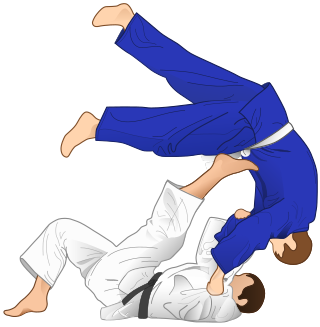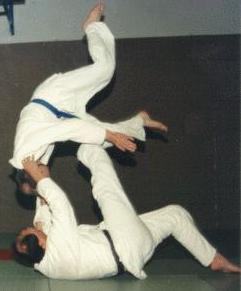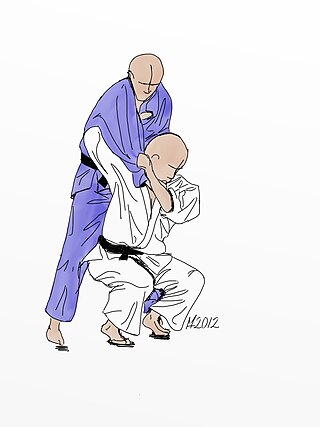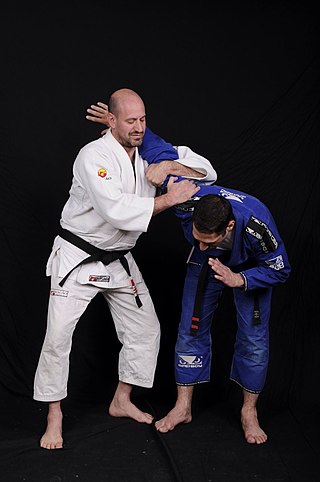
Nage-no-kata is one of the two randori-no-kata of Kodokan Judo. It is intended as an illustration of the various concepts of nage-waza that exist in judo, and is used both as a training method and as a demonstration of understanding.

In martial arts, a throw is a grappling technique that involves off-balancing or lifting an opponent, and throwing them to the ground, in Japanese martial arts referred to as nage-waza, 投げ技, "throwing technique". Throws are a subset of takedown (grappling). Certain throwing techniques called sacrifice throws involve putting oneself in a potentially disadvantageous position, such as on the ground, in order to execute a throw.

Seoi nage is a throw in judo. It is one of the traditional forty throws of judo as developed by Jigoro Kano. It belongs to the first group, Dai Ikkyo, of the traditional throwing list, Gokyo, of Kodokan Judo. It is also part of the current official throws of Kodokan Judo. It is classified as a hand technique, te-waza, and is the second throw performed in the Nage-no-kata. Seoi nage literally means "over the back throw", but has also been translated as a "shoulder throw", as the opponent or uke is thrown over the thrower or tori's shoulder.

Uki Goshi (浮腰) is one of the original 40 throws of Judo as developed by Jigoro Kano. It belongs to the first group, Dai Ikkyo, of the traditional throwing list, Gokyo, of Kodokan Judo. It is also part of the current 67 Throws of Kodokan Judo. It is classified as a hip technique, Koshi-Waza. Uki goshi is known as a favorite throw of Jigoro Kano himself. It is demonstrated in the Nage no Kata. It used to be much drilled in traditional judo dojos.

The ippon seoi nage is a throw in judo. It is a variant of Seoi nage, and is one of the nineteen accepted techniques in Shinmeisho No Waza of Kodokan Judo. It is classified as a hand throwing technique, or te-waza. Ippon seoi nage literally means "one arm over the back throw", but has also been translated as a "one arm shoulder throw", as the opponent or uke is thrown over the thrower or tori's shoulder.

Kata Jūji-jime (片十字絞) is a chokehold in judo. It is one of the twelve constriction techniques of Kodokan Judo in the

Uki otoshi (浮落), or "floating drop," is one of the traditional forty throws of Judo as developed by Jigoro Kano. It belongs to the fourth group, Dai Yonkyo, of the traditional throwing list, Gokyo-no-Nagewaza, of Kodokan Judo. It is also part of the current 67 Throws of Kodokan Judo. The technique is categorized as a hand technique, Te-waza.

Ude-Hishigi-Ude-Gatame (腕挫腕固) is one of the official 29 grappling techniques of Kodokan Judo. It is one of the nine joint techniques of the Kansetsu-waza list, one of the three grappling lists in Judo's

Seoi Otoshi (背負落)

Yoseikan Aikido is the aikido taught at the Yoseikan Dojo in Shizuoka, Japan, under the direction of Minoru Mochizuki.
Gonosen-no-kata is a judo kata that focuses on counter-attacks to throwing techniques. It is not an officially recognized kata of judo, but has acquired disproportionate significance by its inclusion in Kawaishi's The complete seven katas of judo. Writing in the early post-war period, Kawaishi described the kata as "being practiced less in Japan than in Europe".

Shodokan Aikido is the style of Aikido founded by Kenji Tomiki. Shodokan Aikido is sometimes referred to as 合気道競技 meaning "Competitive Aikido" or "Sport Aikido" because of its use of regular competitions.
Practice of Kaeshi no Kata is almost entirely limited to Great-Britain, where until today it has been understood as a judo kata which, like the Gonosen-no-kata, focuses on counter-attacks to throwing techniques. The kata was commonly explained as being an older form than Gonosen-no-kata, that was passed onto Ōtani Masutarō from Tani Yukio.
The Nage-waza ura-no-kata is a judo kata that focuses on counter-attacks to throwing techniques. Its superiority, over Gonosen-no-kata, can be attributed to the fact that it was developed by the sublimely talented Mifune Kyūzō, to be a formal kata, and not some ad hoc collection of counters proceeded by some protocol. The exercise is not an officially recognized Kodokan kata.
Aikido techniques are frequently referred to as waza 技. Aikido training is based primarily on two partners practicing pre-arranged forms (kata) rather than freestyle practice. The basic pattern is for the receiver of the technique (uke) to initiate an attack against the person who applies the technique—the 取り tori, or shite 仕手, also referred to as (投げ nage, who neutralises this attack with an aikido technique.
Atemi waza (当て身技) or body-striking techniques were the strikes from the several ancient traditional Japanese jujitsu styles that were adopted in judo by its designer Jigorō Kanō in 1882 after a comprehensive study, accompanied by uke waza or defending blocks and parries. When judo further developed as a sports discipline, these techniques were excluded from its competition repertoire, which limits itself mainly to throws and holds : although taught within self-defense, kata and sometimes used within informal randori, striking techniques are forbidden in the sport judo competitions rules.










